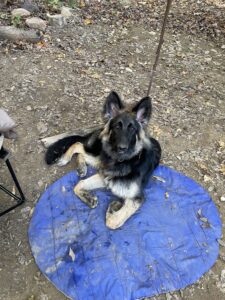One of the most powerful ways to build confidence in dogs is allowing them to take things at their pace. This fosters a curious, pushy attitude – which is exactly what we want when we are trying to help our dogs feel comfortable!
When our dogs have big feelings about something that is associated with predictable cues, their feelings can start to “poison” those other cues. For example, dogs with separation anxiety often start to panic when they see their humans grab their keys and put on their shoes. These dogs are not afraid of keys or shoes, but rather reacting to what those actions lead up to. When our dogs suspect that panic, fear, pain, or other nasty feelings are imminent – they often start feeling those things long before the actual trigger is present.
When we are trying to build confidence, we want our dogs to know that they are in control of the situation. For situations that we are able to suspend while we train (like nail trims, trips to the beach, etc), this is easy to do – you just take a break and resume when your dog is ready! But what if the thing your dog is afraid of still has to happen sometimes, and there’s nothing you can do about it?
That’s where safety signals come in! Safety signals are cues to our dogs that we won’t be pushing them outside their comfort zone, and if they get uncomfortable then the scary thing will stop and we will rescue them. A human example of a safety signal happens at most dentist offices – raising your hand puts a stop to the procedure, just in case you’re feeling discomfort, pain, or if you’re just overwhelmed. (Can you imagine going to a dentist who ignored your request to stop? No thanks!)
We use safety signals in our training set-ups, and don’t use them when we can’t honor them. Their power is in the trust we build – they only work if you can actually put a stop to the scary thing. These enable us to push further in training sessions than we would if our dogs were worried about us going too far.
Some examples of safety signals:
- Chin rest or nose target to opt-in or opt-out of nail trims, grooming, or vet exams
- White noise played during practice departures when working on separation distress
- Standing away from a scary thing so your dog knows they can always return to you to get away from it
- Positioning your dog to sit between your feet when they’re near strangers and don’t want to be petted
- Using a “magic collar” only for outings that are safe and fun
Do we always have to use a safety signal? When can we stop using it?
The only answer here is – ask your dog! We use safety signals to help our dogs feel more comfortable. Sometimes, this extra comfort enables us to make more progress in sessions and our dogs realize that the thing they’re afraid of isn’t so scary! If our sessions demystify the scary stuff for our dogs, and they seem comfortable even without the safety signal – you can set it aside, and pick it up again if you need it.
For other dogs, the safety signal may be there to stay. These dogs struggle with aversion to things – it’s not that they aren’t sure about the thing, they’re positive that they hate it and want no part of it. If their aversion gets to be too much, then they will find a way to set a boundary and escape the situation. In these cases, an opt-out or safety signal behavior can be a safe and non-destructive way for them to say “No.” (If my dog is determined to halt a veterinary exam no matter what, I would much rather she choose to simply move her chin off my hand instead of biting the vet!)



